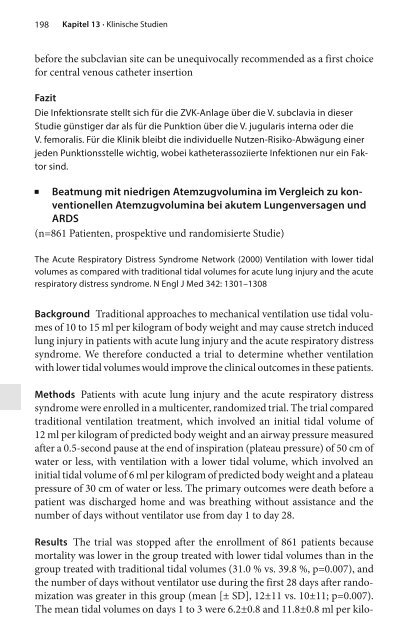Intensivmedizin Fragen und Antworten
Erfolgreiche ePaper selbst erstellen
Machen Sie aus Ihren PDF Publikationen ein blätterbares Flipbook mit unserer einzigartigen Google optimierten e-Paper Software.
198 Kapitel 13 · Klinische Studien<br />
before the subclavian site can be unequivocally recommended as a first choice<br />
for central venous catheter insertion<br />
Fazit<br />
Die Infektionsrate stellt sich für die ZVK-Anlage über die V. subclavia in dieser<br />
Studie günstiger dar als für die Punktion über die V. jugularis interna oder die<br />
V. femoralis. Für die Klinik bleibt die individuelle Nutzen-Risiko-Abwägung einer<br />
jeden Punktionsstelle wichtig, wobei katheterassoziierte Infektionen nur ein Faktor<br />
sind.<br />
jBeatmung mit niedrigen Atemzugvolumina im Vergleich zu konventionellen<br />
Atemzugvolumina bei akutem Lungenversagen <strong>und</strong><br />
ARDS<br />
(n=861 Patienten, prospektive <strong>und</strong> randomisierte Studie)<br />
The Acute Respiratory Distress Syndrome Network (2000) Ventilation with lower tidal<br />
volumes as compared with traditional tidal volumes for acute lung injury and the acute<br />
respiratory distress syndrome. N Engl J Med 342: 1301–1308<br />
Backgro<strong>und</strong> Traditional approaches to mechanical ventilation use tidal volumes<br />
of 10 to 15 ml per kilogram of body weight and may cause stretch induced<br />
lung injury in patients with acute lung injury and the acute respiratory distress<br />
syndrome. We therefore conducted a trial to determine whether ventilation<br />
with lower tidal volumes would improve the clinical outcomes in these patients.<br />
Methods Patients with acute lung injury and the acute respiratory distress<br />
syndrome were enrolled in a multicenter, randomized trial. The trial compared<br />
traditional ventilation treatment, which involved an initial tidal volume of<br />
12 ml per kilogram of predicted body weight and an airway pressure measured<br />
after a 0.5-second pause at the end of inspiration (plateau pressure) of 50 cm of<br />
water or less, with ventilation with a lower tidal volume, which involved an<br />
initial tidal volume of 6 ml per kilogram of predicted body weight and a plateau<br />
pressure of 30 cm of water or less. The primary outcomes were death before a<br />
patient was discharged home and was breathing without assistance and the<br />
number of days without ventilator use from day 1 to day 28.<br />
Results The trial was stopped after the enrollment of 861 patients because<br />
mortality was lower in the group treated with lower tidal volumes than in the<br />
group treated with traditional tidal volumes (31.0 % vs. 39.8 %, p=0.007), and<br />
the number of days without ventilator use during the first 28 days after randomization<br />
was greater in this group (mean [± SD], 12±11 vs. 10±11; p=0.007).<br />
The mean tidal volumes on days 1 to 3 were 6.2±0.8 and 11.8±0.8 ml per kilo-


